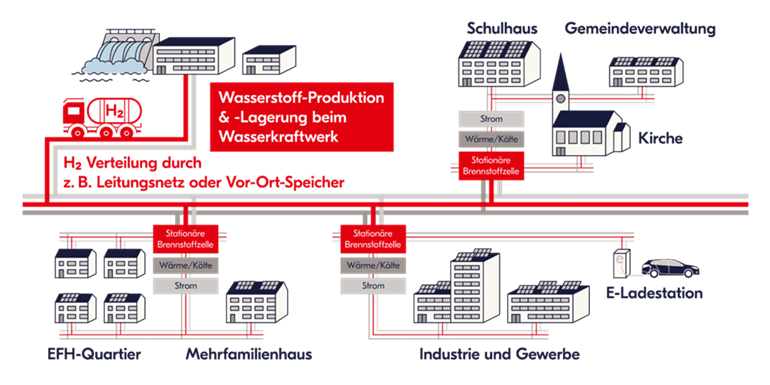Use of stationary hydrogen fuel cells to support the energy transition

The increasing use of photovoltaic and wind energy in the future, which depends on the time of day and weather conditions, poses risks for the Swiss electricity grid. One solution is the use of hydrogen as an energy storage medium, which can be used for environmentally friendly electricity and heat generation in buildings. As an integral system component in the building, the stationary hydrogen fuel cell offers a wide range of innovative benefits for all stakeholders.
Hydropower, photovoltaics and wind power are the mainstays of a renewable and ecologically sustainable energy infrastructure in Switzerland. However, the increased integration of solar energy and wind power into the electricity grid poses certain risks, as these energy sources are volatile in nature and thus pose a potential threat to the grid balance.
The use of hydrogen offers a way to compensate for such energy fluctuations. Surplus, unpredictable solar and wind energy is not fed directly into the grid, but used to produce hydrogen by means of electrolysis. In times of energy shortage, for example caused by no wind and very cloudy weather in winter, the stored hydrogen can be used as an energy source.
Since 2020, the Hälg Group has been working on the topic of “stationary hydrogen fuel cells in buildings”. In this context, a project team of three partner companies was formed: Osterwalder AG in St. Gallen is responsible for the production of green hydrogen through hydropower and its transport, H2Energy acts as a technology and production partner in the field of fuel cells, while the Hälg Group, as a provider of integral building technology and energy systems, is responsible for the planning, implementation and support of the entire building technology building. The vision of this project team is to create ideal energy networks in which environmentally friendly hydrogen as an energy storage medium fills the gaps left by other renewable energies.
Stationary hydrogen fuel cell: a promising approach for a green energy economy
The basis of the hydrogen fuel cell system has existed for almost two centuries. The increased use of hydrogen as an energy medium and substitute for fossil energy sources has led to significant further development of fuel cell technology in the recent past. The production method of hydrogen is essential for the ecological compatibility of this process. So-called “grey” hydrogen is produced by decomposing fossil fuels. Green” hydrogen, on the other hand, is produced by electrolysis of water using environmentally friendly energy sources such as hydropower, solar energy and wind power.
By using only “green” hydrogen in the project group’s ecosystem, the stationary fuel cell generates electricity and heat in an environmentally friendly way. Hydrogen and oxygen are combined in the fuel cell. By applying electrical voltage between an anode and a cathode, the two elements react and combine to form water vapour. In the course of this, electrical energy and heat are also generated, which can be used directly to supply buildings and areas. The water produced in the process is reused.
The hydrogen fuel cell is characterised by its environmental friendliness precisely because no pollutant emissions are produced or released in the course of the chemical reaction. Only pure, low-energy and harmless water vapour escapes as “waste gas”. Consequently, the function of the hydrogen fuel cell is considered to be completely emission-free.
Advantages of the hydrogen fuel cell building technology solution
- Maximises the value of the property and increases its attractiveness
- Enhances the reputation of the facility owner and makes a progressive responsible statement on environmental protection, climate change and green transformation.
- Emergency power supply in the building: partial or full self-sufficiency possible
- Reduction of power and connection costs
- Low maintenance costs due to non-moving parts
- Modular design: from 80 kWel / 78 kWth, scalable as required.
- Reduction of winter electricity demand, grid load, winter electricity gaps
- Assistance in decarbonisation, environmental protection and reduction of greenhouse gases
- Peak shaving of the electrical grid
Ideal energy network
It is important that energy producers and consumers have access to a wide range of environmentally friendly technologies. In addition to hydrogen fuel cells, these include heat pumps, chillers, solar thermal, wind energy and photovoltaics, as well as battery short-term storage and bidirectional e-vehicles. Further information at https://haelg.ch/stationaere-wasserstoff-brennstoffzelle/